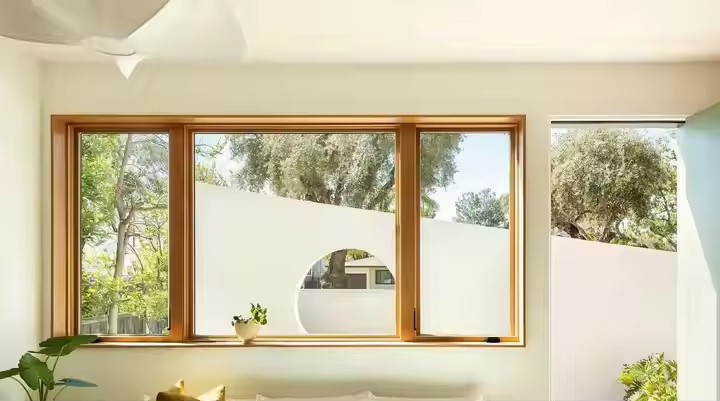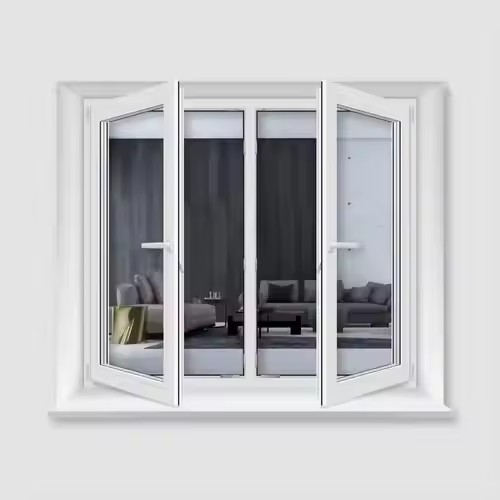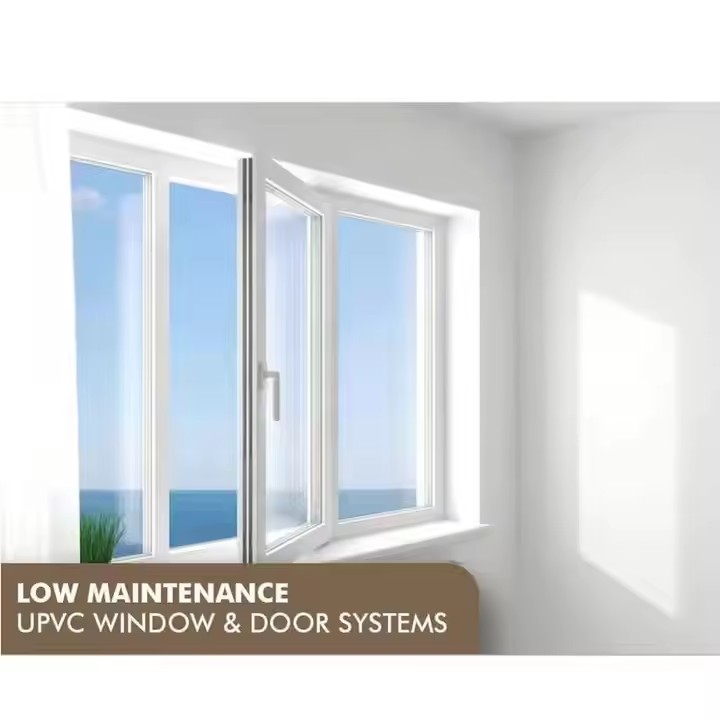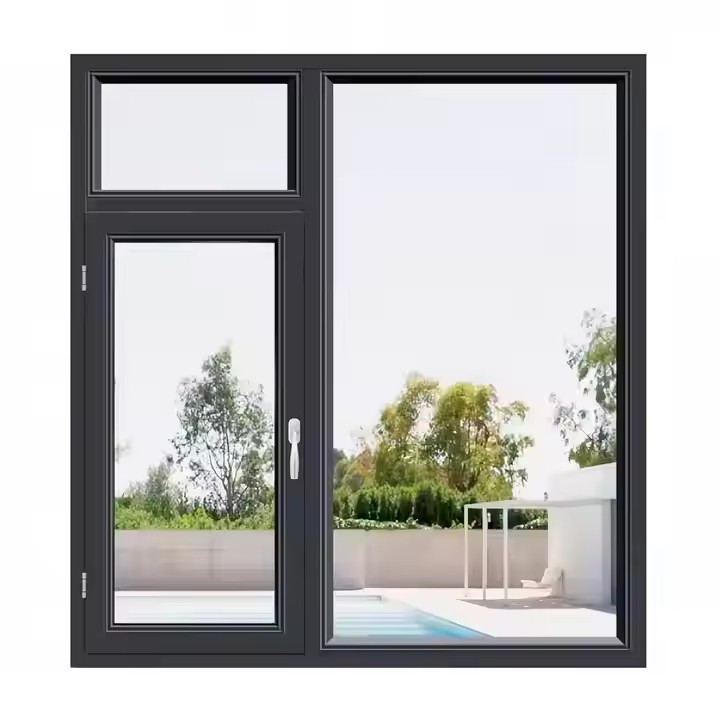Revolutionary Breakthrough in Thermodynamic Performance: Building an Intelligent Barrier for Architectural Insulation
The core competitiveness of thermal break aluminum windows lies in their complete solution to the “thermal bridge effect”. Traditional aluminum alloy profiles, as good conductors of heat, form a heat conduction channel under temperature differences between indoors and outdoors, causing heat loss in winter and cold air infiltration in summer. Thermal break aluminum windows embed PA66 nylon thermal break strips to divide the profiles into independent internal and external structures, forming a physical thermal insulation layer. Combined with multi-chamber profile design, heat conduction efficiency is further reduced through the principle of air insulation. It is these material advantages that make consumers prefer products made of this material.
Extreme Climate Adaptability:
In severely cold regions of Northeast China, thermal break aluminum windows can raise the temperature near the window by 5-8℃, eliminating glass condensation.
In hot and humid areas like Hainan, paired with Low-E insulated glass, the indoor UV transmittance can be reduced by 70%, slowing down furniture aging. In areas with extremely low temperatures, window materials with strong adaptability are required to ensure they can perform well in frigid environments.

Reconstruction of Acoustic Environment: Creating a 30dB Quiet Barrier
The sound insulation performance of thermal break aluminum windows relies on a triple mechanism of “material barrier + structural noise reduction + cavity resonance”:
Acoustic Design of Profiles and Glass:
The multi-chamber structure of aluminum alloy creates a “labyrinth-style” reflection and attenuation of sound waves, while PA66 thermal break strips cut off the sound bridge conduction path.
With 5+20A+5mm insulated glass or 5+PVB+5mm laminated glass, sound insulation of 35-42dB can be achieved.
Scene-based Noise Reduction Performance:
For residential buildings along streets: Reduces 65dB traffic noise to 30dB.
Near airports: Blocks 100dB aircraft takeoff/landing noise to below 45dB.
In industrial areas: Attenuates 80dB mechanical noise to 35dB.
Auxiliary Function of Sealing System:
Three layers of EPDM rubber seals form a closed soundproof cavity. Combined with an equal-pressure cavity design, they prevent wind noise caused by air penetration. Tested at wind speed level 6, the noise at the window sash edge is ≤30dB.
Ultimate Optimization of Structural Mechanics: Architectural Armor against Extreme Weather
Thermal break aluminum windows achieve a leap in wind pressure resistance through the synergy of material strength and structural design:
Profile Mechanical Parameters:
Using 6063-T5 aluminum alloy profiles (tensile strength ≥160MPa, yield strength ≥110MPa), combined with thermal break strips to form a “rigid-flexible composite” structure. In the wind pressure resistance test of GB/T 7106-2019, high-performance thermal break aluminum windows can withstand 5.0kPa wind pressure (equivalent to a category 14 typhoon), with sash deformation ≤L/120 (L is the profile length).
Solutions for High-rise Buildings:
For buildings above 30 stories, enhance wind resistance by:
Increasing profile wall thickness to 1.8mm
Adding middle stile reinforcing ribs
Adopting dowel pin glue injection corner joining technology (corner strength increased by 40%)
Paired with tempered glass (wind pressure resistance 90MPa)
Air Tightness and Watertightness:
Air tightness reaches level 8 (GB/T 7107-2019), with air permeability ≤0.5m³/(m·h).
Rainwater leakage performance reaches level 6, resisting continuous heavy rain under 250Pa pressure. The drainage 槽 (drainage groove) design ensures a drainage capacity of ≥15L per minute.

Innovation in Waterproof Sealing System: A Precision Engineering to Prevent Leakage
Thermal break aluminum windows build a multi-layer protection system based on the “combination of diversion and blocking” waterproof concept:
Sealing Structure Analysis:
Main sealing layer: Double-layer EPDM rubber strips (compression 15%-20%) between sash and frame form the first waterproof barrier.
Corner sealing: Adopts injected glue corner fittings + corner glue technology (tensile strength after curing ≥3.5MPa) to eliminate gaps at 90° joints.
Glass sealing: Insulated glass uses double-seal (butyl rubber + silicone structural sealant), with water vapor permeability ≤0.1g/(㎡·d).
Innovative Drainage System:
The bottom of the window frame is designed with hidden drainage grooves, combined with inclined drainage holes (diameter 10mm) and waterproof covers, forming a “gravity drainage + air pressure balance” mechanism. In heavy rain conditions, drainage efficiency is 3 times higher than traditional windows, preventing backflow.
Durability Revolution in Material Science: A 20-Year Maintenance-Free Quality Commitment
The long lifespan of thermal break aluminum windows benefits from dual guarantees of material anti-corrosion and surface treatment:
Anti-Corrosion Performance Parameters:
Aluminum alloy profiles with fluorocarbon spraying (coating thickness ≥30μm) pass 1000-hour salt spray test (5% NaCl solution) without corrosion.
PA66 thermal break strips have weather resistance from -40℃ to +120℃, maintaining shape after long-term use.
EPDM rubber strips have ozone aging resistance ≥5000 hours (GB/T 7762-2014).
Service Life Comparison:
Window Type Average Service Life Annual Maintenance Cost
Ordinary aluminum window 8-10 years $150-200/year
Maintenance Cost Advantage:
Thermal break aluminum windows only require annual cleaning of seals and drainage grooves, without replacing profiles or seals. Over a 20-year period, maintenance costs are reduced by over 60% compared to ordinary windows.

Diverse Adaptability in Architectural Aesthetics: Crossing Boundaries from Function to Art
Thermal break aluminum windows break through the styling limitations of traditional doors and windows, becoming design elements of building facades:
Customized Appearance Solutions:
Color system: Powder coating enables full-color customization according to RAL color cards; wood grain transfer technology (thermal transfer at 220℃) simulates walnut, oak, etc., suitable for traditional Chinese architecture.
Profile section: Narrow frame design (visible width 28mm) increases daylighting by 15%, ideal for minimalist architecture; curved profiles meet special-shaped window design needs.
Innovative Glass Art:
Customizable glazed glass, wired glass, and electrochromic glass balance functionality and decoration.

